Accounting Info Systems: Evaluating Queensland Health Payroll Project
VerifiedAdded on 2024/05/16
|12
|2705
|161
Report
AI Summary
This report critically evaluates the Queensland Health Payroll project failure, considered the largest in the southern hemisphere, through the lens of accounting information systems. It discusses the application of control frameworks like COSO and COBIT, examining their potential impact on the project's success and analyzing their actual implementation by the Queensland Health project team. The report assesses the work accomplished within the system development life cycle, highlighting deficiencies in requirements definition and implementation strategy. Key findings reveal the project's unique complexity, payroll processing accountability issues, and the lack of a specific project management methodology. Recommendations emphasize the adoption of a robust project management methodology, skilled personnel, rigorous application of program methodologies, and a well-defined reporting regime to ensure project success. The report concludes by underscoring the importance of these factors in preventing similar failures in future projects.

Accounting Information Systems
1
1
Paraphrase This Document
Need a fresh take? Get an instant paraphrase of this document with our AI Paraphraser
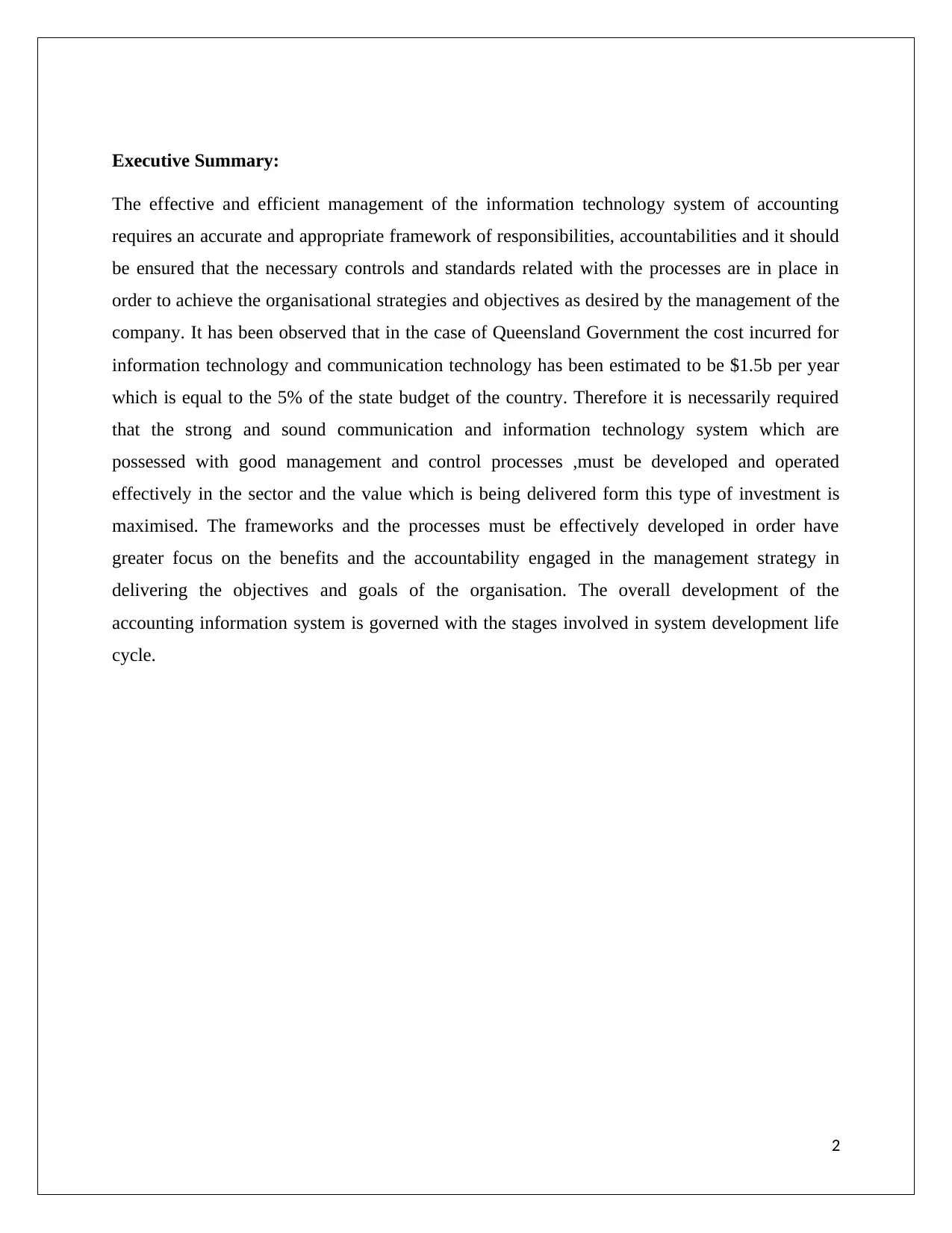
Executive Summary:
The effective and efficient management of the information technology system of accounting
requires an accurate and appropriate framework of responsibilities, accountabilities and it should
be ensured that the necessary controls and standards related with the processes are in place in
order to achieve the organisational strategies and objectives as desired by the management of the
company. It has been observed that in the case of Queensland Government the cost incurred for
information technology and communication technology has been estimated to be $1.5b per year
which is equal to the 5% of the state budget of the country. Therefore it is necessarily required
that the strong and sound communication and information technology system which are
possessed with good management and control processes ,must be developed and operated
effectively in the sector and the value which is being delivered form this type of investment is
maximised. The frameworks and the processes must be effectively developed in order have
greater focus on the benefits and the accountability engaged in the management strategy in
delivering the objectives and goals of the organisation. The overall development of the
accounting information system is governed with the stages involved in system development life
cycle.
2
The effective and efficient management of the information technology system of accounting
requires an accurate and appropriate framework of responsibilities, accountabilities and it should
be ensured that the necessary controls and standards related with the processes are in place in
order to achieve the organisational strategies and objectives as desired by the management of the
company. It has been observed that in the case of Queensland Government the cost incurred for
information technology and communication technology has been estimated to be $1.5b per year
which is equal to the 5% of the state budget of the country. Therefore it is necessarily required
that the strong and sound communication and information technology system which are
possessed with good management and control processes ,must be developed and operated
effectively in the sector and the value which is being delivered form this type of investment is
maximised. The frameworks and the processes must be effectively developed in order have
greater focus on the benefits and the accountability engaged in the management strategy in
delivering the objectives and goals of the organisation. The overall development of the
accounting information system is governed with the stages involved in system development life
cycle.
2
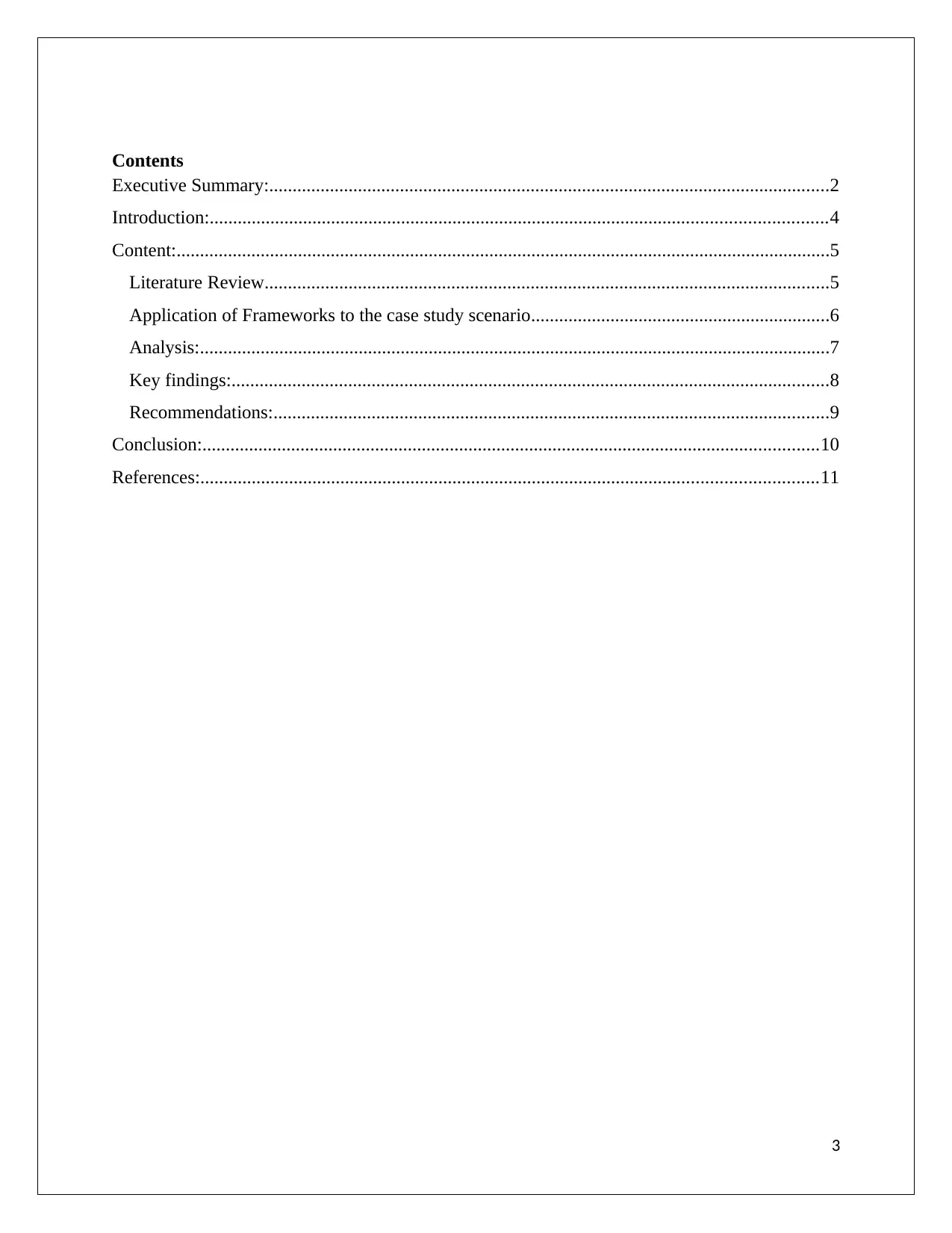
Contents
Executive Summary:........................................................................................................................2
Introduction:....................................................................................................................................4
Content:............................................................................................................................................5
Literature Review.........................................................................................................................5
Application of Frameworks to the case study scenario................................................................6
Analysis:.......................................................................................................................................7
Key findings:................................................................................................................................8
Recommendations:.......................................................................................................................9
Conclusion:....................................................................................................................................10
References:....................................................................................................................................11
3
Executive Summary:........................................................................................................................2
Introduction:....................................................................................................................................4
Content:............................................................................................................................................5
Literature Review.........................................................................................................................5
Application of Frameworks to the case study scenario................................................................6
Analysis:.......................................................................................................................................7
Key findings:................................................................................................................................8
Recommendations:.......................................................................................................................9
Conclusion:....................................................................................................................................10
References:....................................................................................................................................11
3
⊘ This is a preview!⊘
Do you want full access?
Subscribe today to unlock all pages.

Trusted by 1+ million students worldwide
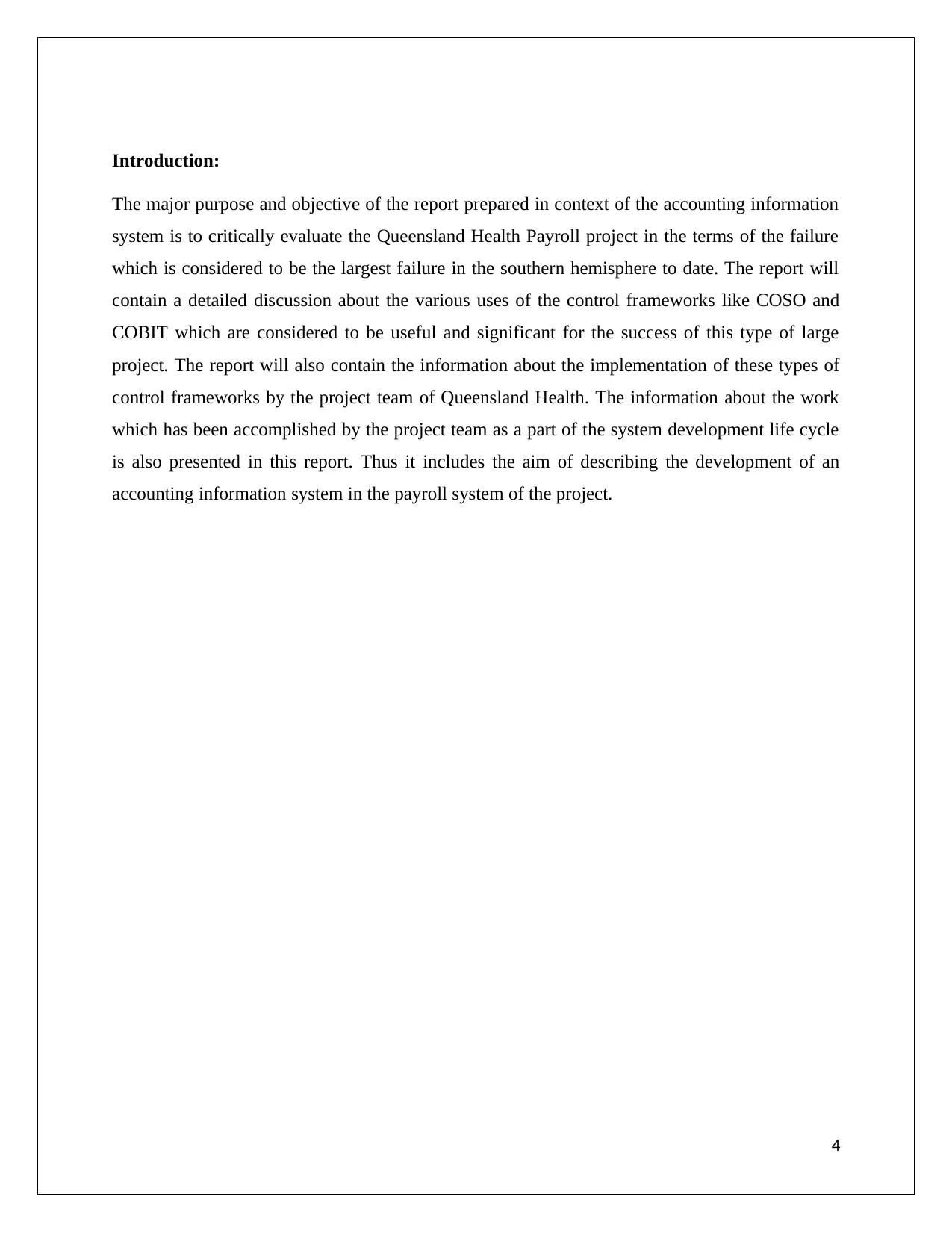
Introduction:
The major purpose and objective of the report prepared in context of the accounting information
system is to critically evaluate the Queensland Health Payroll project in the terms of the failure
which is considered to be the largest failure in the southern hemisphere to date. The report will
contain a detailed discussion about the various uses of the control frameworks like COSO and
COBIT which are considered to be useful and significant for the success of this type of large
project. The report will also contain the information about the implementation of these types of
control frameworks by the project team of Queensland Health. The information about the work
which has been accomplished by the project team as a part of the system development life cycle
is also presented in this report. Thus it includes the aim of describing the development of an
accounting information system in the payroll system of the project.
4
The major purpose and objective of the report prepared in context of the accounting information
system is to critically evaluate the Queensland Health Payroll project in the terms of the failure
which is considered to be the largest failure in the southern hemisphere to date. The report will
contain a detailed discussion about the various uses of the control frameworks like COSO and
COBIT which are considered to be useful and significant for the success of this type of large
project. The report will also contain the information about the implementation of these types of
control frameworks by the project team of Queensland Health. The information about the work
which has been accomplished by the project team as a part of the system development life cycle
is also presented in this report. Thus it includes the aim of describing the development of an
accounting information system in the payroll system of the project.
4
Paraphrase This Document
Need a fresh take? Get an instant paraphrase of this document with our AI Paraphraser
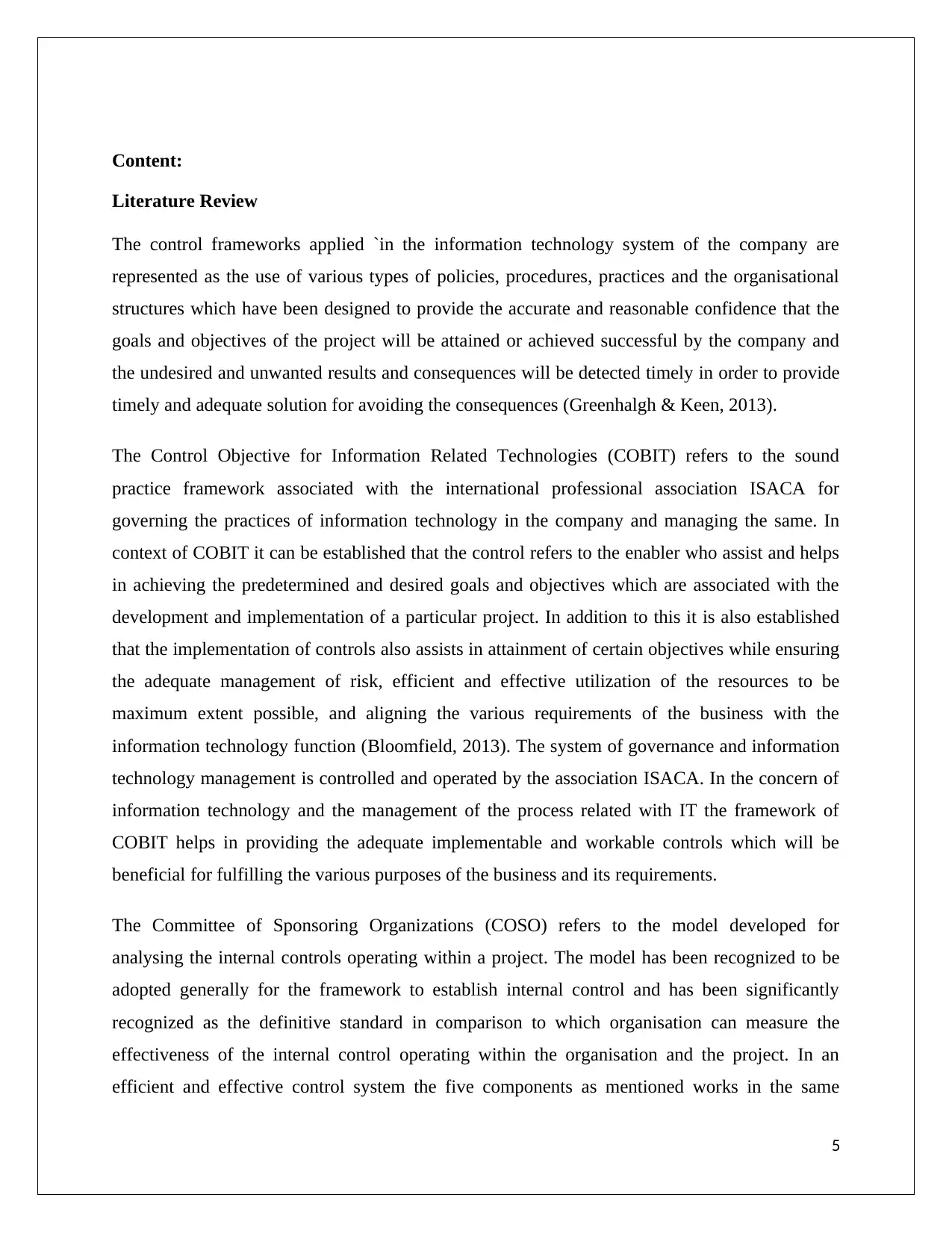
Content:
Literature Review
The control frameworks applied `in the information technology system of the company are
represented as the use of various types of policies, procedures, practices and the organisational
structures which have been designed to provide the accurate and reasonable confidence that the
goals and objectives of the project will be attained or achieved successful by the company and
the undesired and unwanted results and consequences will be detected timely in order to provide
timely and adequate solution for avoiding the consequences (Greenhalgh & Keen, 2013).
The Control Objective for Information Related Technologies (COBIT) refers to the sound
practice framework associated with the international professional association ISACA for
governing the practices of information technology in the company and managing the same. In
context of COBIT it can be established that the control refers to the enabler who assist and helps
in achieving the predetermined and desired goals and objectives which are associated with the
development and implementation of a particular project. In addition to this it is also established
that the implementation of controls also assists in attainment of certain objectives while ensuring
the adequate management of risk, efficient and effective utilization of the resources to be
maximum extent possible, and aligning the various requirements of the business with the
information technology function (Bloomfield, 2013). The system of governance and information
technology management is controlled and operated by the association ISACA. In the concern of
information technology and the management of the process related with IT the framework of
COBIT helps in providing the adequate implementable and workable controls which will be
beneficial for fulfilling the various purposes of the business and its requirements.
The Committee of Sponsoring Organizations (COSO) refers to the model developed for
analysing the internal controls operating within a project. The model has been recognized to be
adopted generally for the framework to establish internal control and has been significantly
recognized as the definitive standard in comparison to which organisation can measure the
effectiveness of the internal control operating within the organisation and the project. In an
efficient and effective control system the five components as mentioned works in the same
5
Literature Review
The control frameworks applied `in the information technology system of the company are
represented as the use of various types of policies, procedures, practices and the organisational
structures which have been designed to provide the accurate and reasonable confidence that the
goals and objectives of the project will be attained or achieved successful by the company and
the undesired and unwanted results and consequences will be detected timely in order to provide
timely and adequate solution for avoiding the consequences (Greenhalgh & Keen, 2013).
The Control Objective for Information Related Technologies (COBIT) refers to the sound
practice framework associated with the international professional association ISACA for
governing the practices of information technology in the company and managing the same. In
context of COBIT it can be established that the control refers to the enabler who assist and helps
in achieving the predetermined and desired goals and objectives which are associated with the
development and implementation of a particular project. In addition to this it is also established
that the implementation of controls also assists in attainment of certain objectives while ensuring
the adequate management of risk, efficient and effective utilization of the resources to be
maximum extent possible, and aligning the various requirements of the business with the
information technology function (Bloomfield, 2013). The system of governance and information
technology management is controlled and operated by the association ISACA. In the concern of
information technology and the management of the process related with IT the framework of
COBIT helps in providing the adequate implementable and workable controls which will be
beneficial for fulfilling the various purposes of the business and its requirements.
The Committee of Sponsoring Organizations (COSO) refers to the model developed for
analysing the internal controls operating within a project. The model has been recognized to be
adopted generally for the framework to establish internal control and has been significantly
recognized as the definitive standard in comparison to which organisation can measure the
effectiveness of the internal control operating within the organisation and the project. In an
efficient and effective control system the five components as mentioned works in the same
5
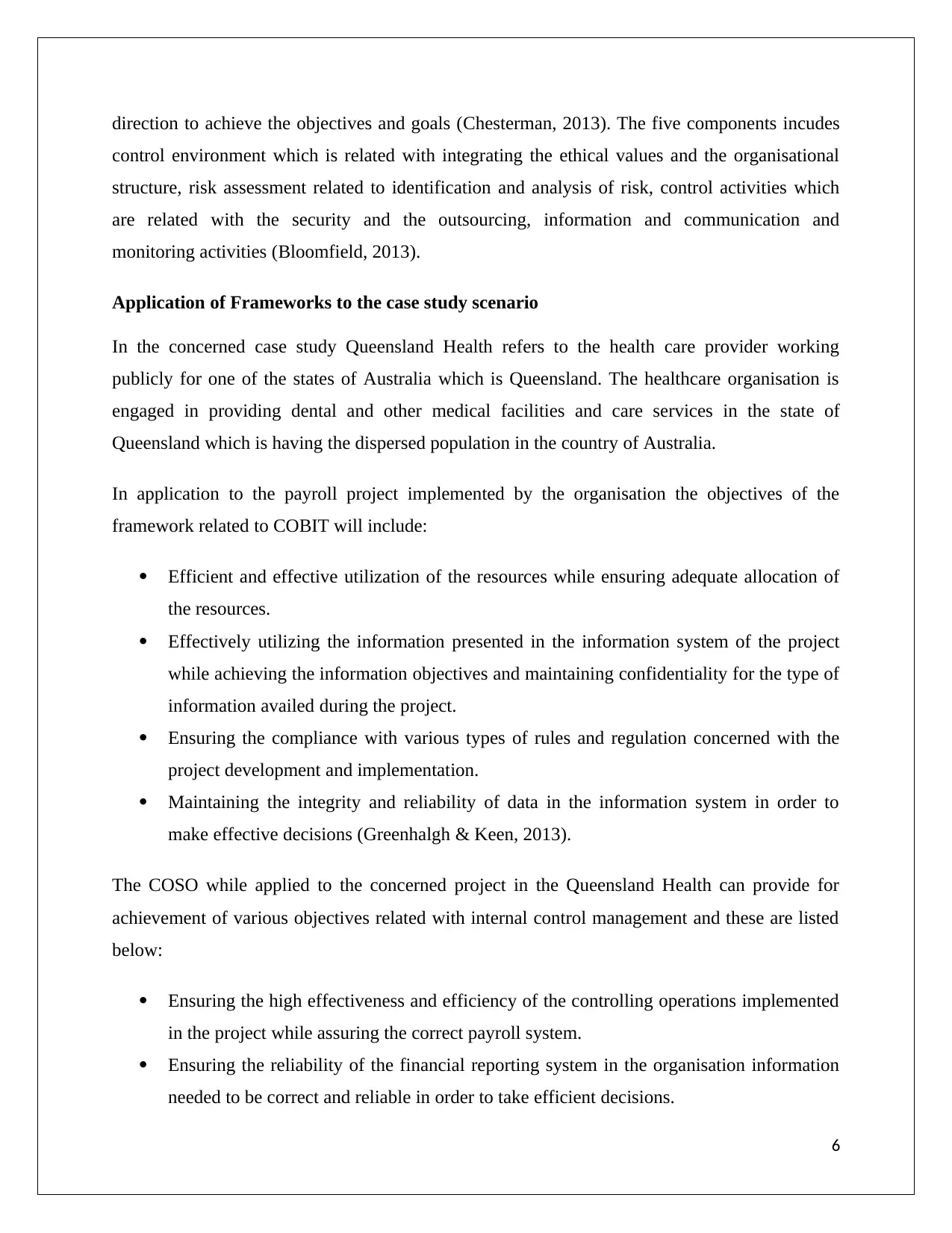
direction to achieve the objectives and goals (Chesterman, 2013). The five components incudes
control environment which is related with integrating the ethical values and the organisational
structure, risk assessment related to identification and analysis of risk, control activities which
are related with the security and the outsourcing, information and communication and
monitoring activities (Bloomfield, 2013).
Application of Frameworks to the case study scenario
In the concerned case study Queensland Health refers to the health care provider working
publicly for one of the states of Australia which is Queensland. The healthcare organisation is
engaged in providing dental and other medical facilities and care services in the state of
Queensland which is having the dispersed population in the country of Australia.
In application to the payroll project implemented by the organisation the objectives of the
framework related to COBIT will include:
Efficient and effective utilization of the resources while ensuring adequate allocation of
the resources.
Effectively utilizing the information presented in the information system of the project
while achieving the information objectives and maintaining confidentiality for the type of
information availed during the project.
Ensuring the compliance with various types of rules and regulation concerned with the
project development and implementation.
Maintaining the integrity and reliability of data in the information system in order to
make effective decisions (Greenhalgh & Keen, 2013).
The COSO while applied to the concerned project in the Queensland Health can provide for
achievement of various objectives related with internal control management and these are listed
below:
Ensuring the high effectiveness and efficiency of the controlling operations implemented
in the project while assuring the correct payroll system.
Ensuring the reliability of the financial reporting system in the organisation information
needed to be correct and reliable in order to take efficient decisions.
6
control environment which is related with integrating the ethical values and the organisational
structure, risk assessment related to identification and analysis of risk, control activities which
are related with the security and the outsourcing, information and communication and
monitoring activities (Bloomfield, 2013).
Application of Frameworks to the case study scenario
In the concerned case study Queensland Health refers to the health care provider working
publicly for one of the states of Australia which is Queensland. The healthcare organisation is
engaged in providing dental and other medical facilities and care services in the state of
Queensland which is having the dispersed population in the country of Australia.
In application to the payroll project implemented by the organisation the objectives of the
framework related to COBIT will include:
Efficient and effective utilization of the resources while ensuring adequate allocation of
the resources.
Effectively utilizing the information presented in the information system of the project
while achieving the information objectives and maintaining confidentiality for the type of
information availed during the project.
Ensuring the compliance with various types of rules and regulation concerned with the
project development and implementation.
Maintaining the integrity and reliability of data in the information system in order to
make effective decisions (Greenhalgh & Keen, 2013).
The COSO while applied to the concerned project in the Queensland Health can provide for
achievement of various objectives related with internal control management and these are listed
below:
Ensuring the high effectiveness and efficiency of the controlling operations implemented
in the project while assuring the correct payroll system.
Ensuring the reliability of the financial reporting system in the organisation information
needed to be correct and reliable in order to take efficient decisions.
6
⊘ This is a preview!⊘
Do you want full access?
Subscribe today to unlock all pages.

Trusted by 1+ million students worldwide
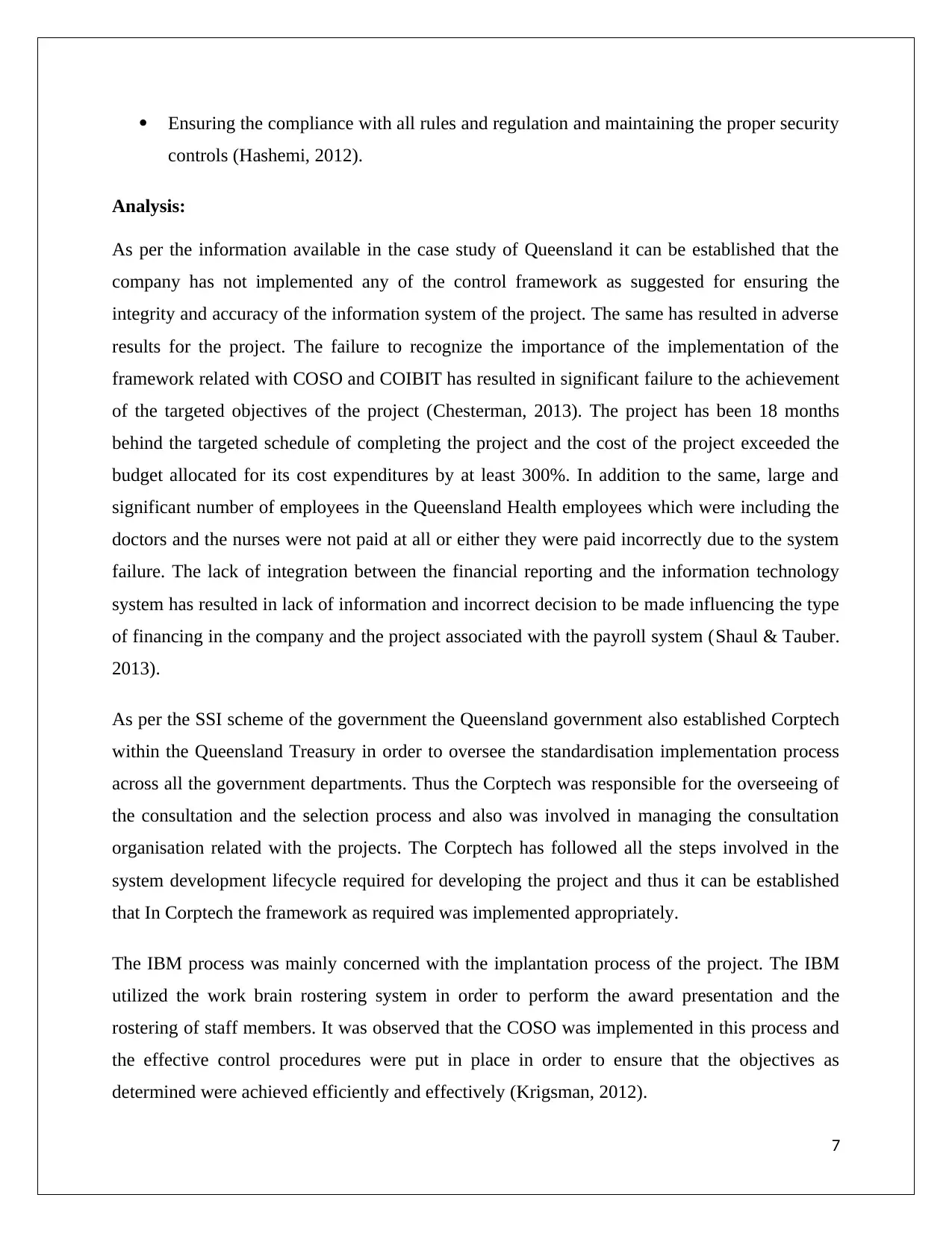
Ensuring the compliance with all rules and regulation and maintaining the proper security
controls (Hashemi, 2012).
Analysis:
As per the information available in the case study of Queensland it can be established that the
company has not implemented any of the control framework as suggested for ensuring the
integrity and accuracy of the information system of the project. The same has resulted in adverse
results for the project. The failure to recognize the importance of the implementation of the
framework related with COSO and COIBIT has resulted in significant failure to the achievement
of the targeted objectives of the project (Chesterman, 2013). The project has been 18 months
behind the targeted schedule of completing the project and the cost of the project exceeded the
budget allocated for its cost expenditures by at least 300%. In addition to the same, large and
significant number of employees in the Queensland Health employees which were including the
doctors and the nurses were not paid at all or either they were paid incorrectly due to the system
failure. The lack of integration between the financial reporting and the information technology
system has resulted in lack of information and incorrect decision to be made influencing the type
of financing in the company and the project associated with the payroll system (Shaul & Tauber.
2013).
As per the SSI scheme of the government the Queensland government also established Corptech
within the Queensland Treasury in order to oversee the standardisation implementation process
across all the government departments. Thus the Corptech was responsible for the overseeing of
the consultation and the selection process and also was involved in managing the consultation
organisation related with the projects. The Corptech has followed all the steps involved in the
system development lifecycle required for developing the project and thus it can be established
that In Corptech the framework as required was implemented appropriately.
The IBM process was mainly concerned with the implantation process of the project. The IBM
utilized the work brain rostering system in order to perform the award presentation and the
rostering of staff members. It was observed that the COSO was implemented in this process and
the effective control procedures were put in place in order to ensure that the objectives as
determined were achieved efficiently and effectively (Krigsman, 2012).
7
controls (Hashemi, 2012).
Analysis:
As per the information available in the case study of Queensland it can be established that the
company has not implemented any of the control framework as suggested for ensuring the
integrity and accuracy of the information system of the project. The same has resulted in adverse
results for the project. The failure to recognize the importance of the implementation of the
framework related with COSO and COIBIT has resulted in significant failure to the achievement
of the targeted objectives of the project (Chesterman, 2013). The project has been 18 months
behind the targeted schedule of completing the project and the cost of the project exceeded the
budget allocated for its cost expenditures by at least 300%. In addition to the same, large and
significant number of employees in the Queensland Health employees which were including the
doctors and the nurses were not paid at all or either they were paid incorrectly due to the system
failure. The lack of integration between the financial reporting and the information technology
system has resulted in lack of information and incorrect decision to be made influencing the type
of financing in the company and the project associated with the payroll system (Shaul & Tauber.
2013).
As per the SSI scheme of the government the Queensland government also established Corptech
within the Queensland Treasury in order to oversee the standardisation implementation process
across all the government departments. Thus the Corptech was responsible for the overseeing of
the consultation and the selection process and also was involved in managing the consultation
organisation related with the projects. The Corptech has followed all the steps involved in the
system development lifecycle required for developing the project and thus it can be established
that In Corptech the framework as required was implemented appropriately.
The IBM process was mainly concerned with the implantation process of the project. The IBM
utilized the work brain rostering system in order to perform the award presentation and the
rostering of staff members. It was observed that the COSO was implemented in this process and
the effective control procedures were put in place in order to ensure that the objectives as
determined were achieved efficiently and effectively (Krigsman, 2012).
7
Paraphrase This Document
Need a fresh take? Get an instant paraphrase of this document with our AI Paraphraser
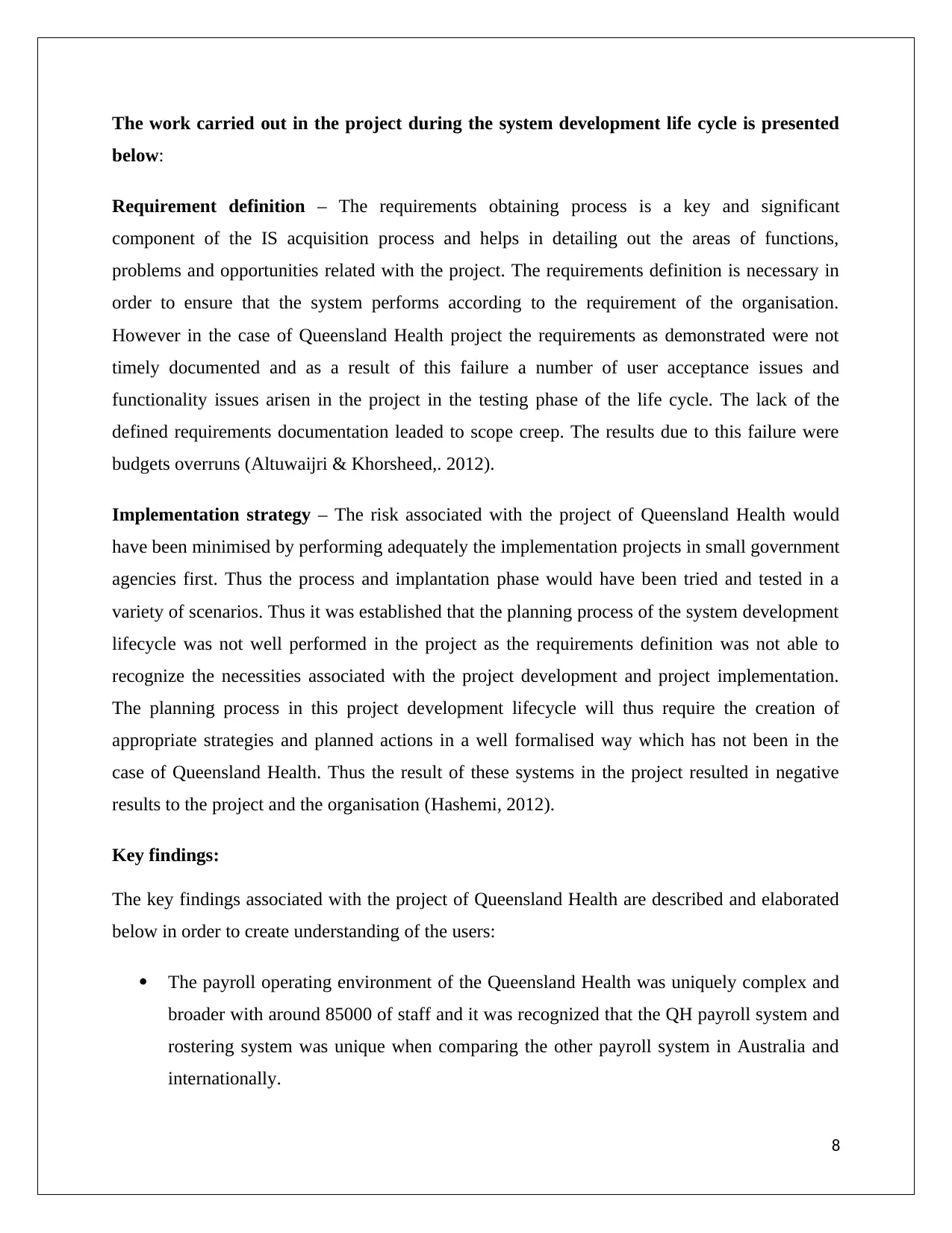
The work carried out in the project during the system development life cycle is presented
below:
Requirement definition – The requirements obtaining process is a key and significant
component of the IS acquisition process and helps in detailing out the areas of functions,
problems and opportunities related with the project. The requirements definition is necessary in
order to ensure that the system performs according to the requirement of the organisation.
However in the case of Queensland Health project the requirements as demonstrated were not
timely documented and as a result of this failure a number of user acceptance issues and
functionality issues arisen in the project in the testing phase of the life cycle. The lack of the
defined requirements documentation leaded to scope creep. The results due to this failure were
budgets overruns (Altuwaijri & Khorsheed,. 2012).
Implementation strategy – The risk associated with the project of Queensland Health would
have been minimised by performing adequately the implementation projects in small government
agencies first. Thus the process and implantation phase would have been tried and tested in a
variety of scenarios. Thus it was established that the planning process of the system development
lifecycle was not well performed in the project as the requirements definition was not able to
recognize the necessities associated with the project development and project implementation.
The planning process in this project development lifecycle will thus require the creation of
appropriate strategies and planned actions in a well formalised way which has not been in the
case of Queensland Health. Thus the result of these systems in the project resulted in negative
results to the project and the organisation (Hashemi, 2012).
Key findings:
The key findings associated with the project of Queensland Health are described and elaborated
below in order to create understanding of the users:
The payroll operating environment of the Queensland Health was uniquely complex and
broader with around 85000 of staff and it was recognized that the QH payroll system and
rostering system was unique when comparing the other payroll system in Australia and
internationally.
8
below:
Requirement definition – The requirements obtaining process is a key and significant
component of the IS acquisition process and helps in detailing out the areas of functions,
problems and opportunities related with the project. The requirements definition is necessary in
order to ensure that the system performs according to the requirement of the organisation.
However in the case of Queensland Health project the requirements as demonstrated were not
timely documented and as a result of this failure a number of user acceptance issues and
functionality issues arisen in the project in the testing phase of the life cycle. The lack of the
defined requirements documentation leaded to scope creep. The results due to this failure were
budgets overruns (Altuwaijri & Khorsheed,. 2012).
Implementation strategy – The risk associated with the project of Queensland Health would
have been minimised by performing adequately the implementation projects in small government
agencies first. Thus the process and implantation phase would have been tried and tested in a
variety of scenarios. Thus it was established that the planning process of the system development
lifecycle was not well performed in the project as the requirements definition was not able to
recognize the necessities associated with the project development and project implementation.
The planning process in this project development lifecycle will thus require the creation of
appropriate strategies and planned actions in a well formalised way which has not been in the
case of Queensland Health. Thus the result of these systems in the project resulted in negative
results to the project and the organisation (Hashemi, 2012).
Key findings:
The key findings associated with the project of Queensland Health are described and elaborated
below in order to create understanding of the users:
The payroll operating environment of the Queensland Health was uniquely complex and
broader with around 85000 of staff and it was recognized that the QH payroll system and
rostering system was unique when comparing the other payroll system in Australia and
internationally.
8
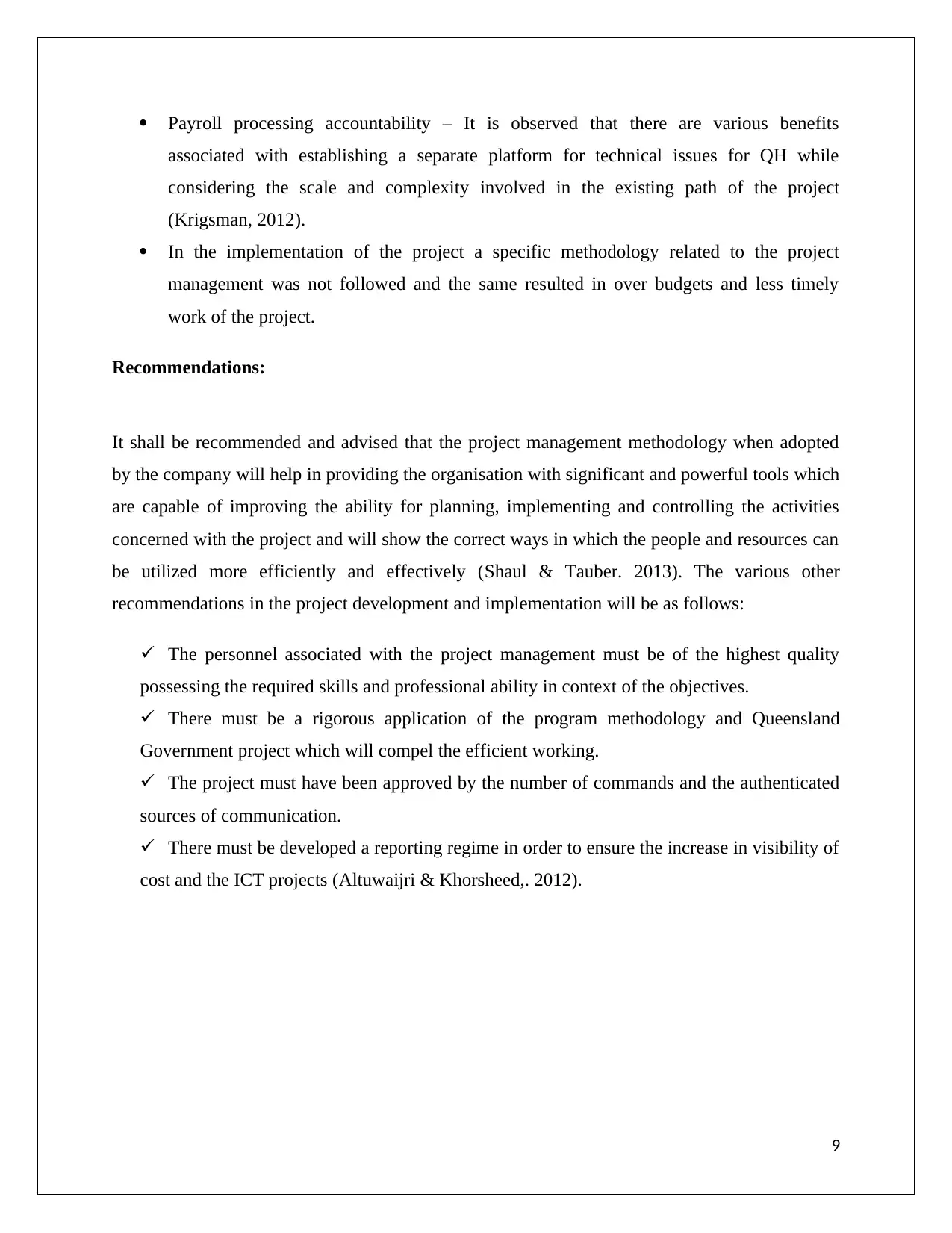
Payroll processing accountability – It is observed that there are various benefits
associated with establishing a separate platform for technical issues for QH while
considering the scale and complexity involved in the existing path of the project
(Krigsman, 2012).
In the implementation of the project a specific methodology related to the project
management was not followed and the same resulted in over budgets and less timely
work of the project.
Recommendations:
It shall be recommended and advised that the project management methodology when adopted
by the company will help in providing the organisation with significant and powerful tools which
are capable of improving the ability for planning, implementing and controlling the activities
concerned with the project and will show the correct ways in which the people and resources can
be utilized more efficiently and effectively (Shaul & Tauber. 2013). The various other
recommendations in the project development and implementation will be as follows:
The personnel associated with the project management must be of the highest quality
possessing the required skills and professional ability in context of the objectives.
There must be a rigorous application of the program methodology and Queensland
Government project which will compel the efficient working.
The project must have been approved by the number of commands and the authenticated
sources of communication.
There must be developed a reporting regime in order to ensure the increase in visibility of
cost and the ICT projects (Altuwaijri & Khorsheed,. 2012).
9
associated with establishing a separate platform for technical issues for QH while
considering the scale and complexity involved in the existing path of the project
(Krigsman, 2012).
In the implementation of the project a specific methodology related to the project
management was not followed and the same resulted in over budgets and less timely
work of the project.
Recommendations:
It shall be recommended and advised that the project management methodology when adopted
by the company will help in providing the organisation with significant and powerful tools which
are capable of improving the ability for planning, implementing and controlling the activities
concerned with the project and will show the correct ways in which the people and resources can
be utilized more efficiently and effectively (Shaul & Tauber. 2013). The various other
recommendations in the project development and implementation will be as follows:
The personnel associated with the project management must be of the highest quality
possessing the required skills and professional ability in context of the objectives.
There must be a rigorous application of the program methodology and Queensland
Government project which will compel the efficient working.
The project must have been approved by the number of commands and the authenticated
sources of communication.
There must be developed a reporting regime in order to ensure the increase in visibility of
cost and the ICT projects (Altuwaijri & Khorsheed,. 2012).
9
⊘ This is a preview!⊘
Do you want full access?
Subscribe today to unlock all pages.

Trusted by 1+ million students worldwide
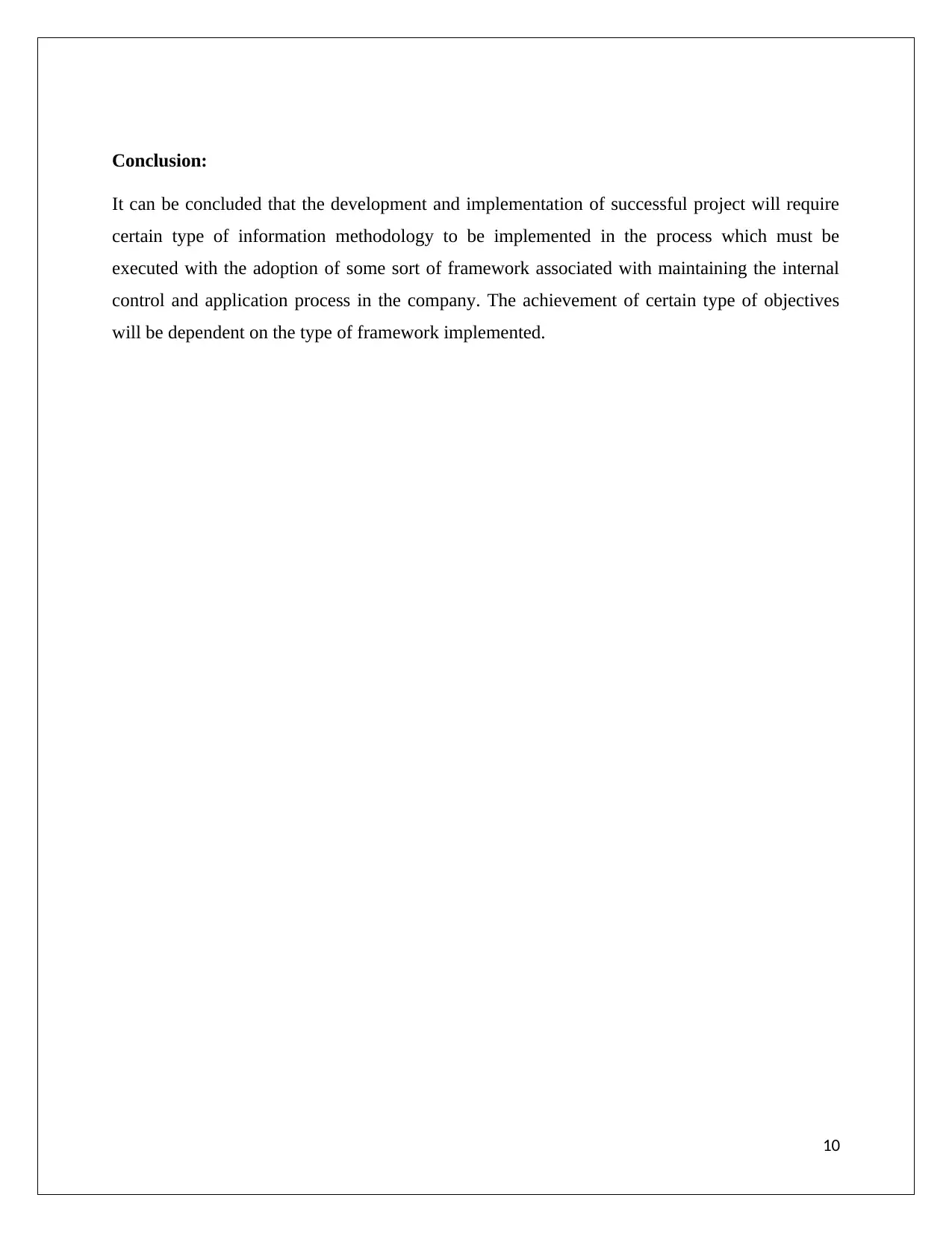
Conclusion:
It can be concluded that the development and implementation of successful project will require
certain type of information methodology to be implemented in the process which must be
executed with the adoption of some sort of framework associated with maintaining the internal
control and application process in the company. The achievement of certain type of objectives
will be dependent on the type of framework implemented.
10
It can be concluded that the development and implementation of successful project will require
certain type of information methodology to be implemented in the process which must be
executed with the adoption of some sort of framework associated with maintaining the internal
control and application process in the company. The achievement of certain type of objectives
will be dependent on the type of framework implemented.
10
Paraphrase This Document
Need a fresh take? Get an instant paraphrase of this document with our AI Paraphraser
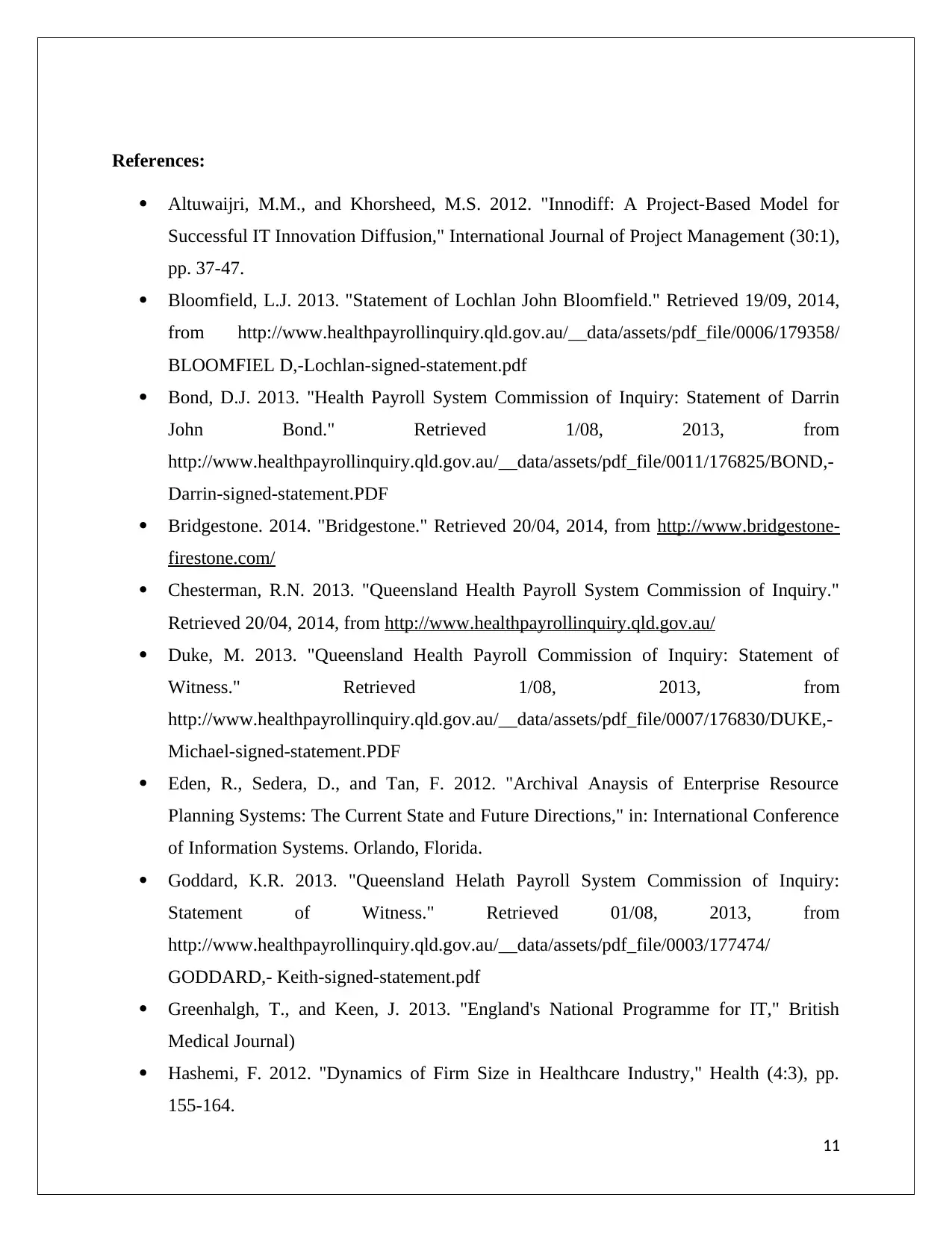
References:
Altuwaijri, M.M., and Khorsheed, M.S. 2012. "Innodiff: A Project-Based Model for
Successful IT Innovation Diffusion," International Journal of Project Management (30:1),
pp. 37-47.
Bloomfield, L.J. 2013. "Statement of Lochlan John Bloomfield." Retrieved 19/09, 2014,
from http://www.healthpayrollinquiry.qld.gov.au/__data/assets/pdf_file/0006/179358/
BLOOMFIEL D,-Lochlan-signed-statement.pdf
Bond, D.J. 2013. "Health Payroll System Commission of Inquiry: Statement of Darrin
John Bond." Retrieved 1/08, 2013, from
http://www.healthpayrollinquiry.qld.gov.au/__data/assets/pdf_file/0011/176825/BOND,-
Darrin-signed-statement.PDF
Bridgestone. 2014. "Bridgestone." Retrieved 20/04, 2014, from http://www.bridgestone-
firestone.com/
Chesterman, R.N. 2013. "Queensland Health Payroll System Commission of Inquiry."
Retrieved 20/04, 2014, from http://www.healthpayrollinquiry.qld.gov.au/
Duke, M. 2013. "Queensland Health Payroll Commission of Inquiry: Statement of
Witness." Retrieved 1/08, 2013, from
http://www.healthpayrollinquiry.qld.gov.au/__data/assets/pdf_file/0007/176830/DUKE,-
Michael-signed-statement.PDF
Eden, R., Sedera, D., and Tan, F. 2012. "Archival Anaysis of Enterprise Resource
Planning Systems: The Current State and Future Directions," in: International Conference
of Information Systems. Orlando, Florida.
Goddard, K.R. 2013. "Queensland Helath Payroll System Commission of Inquiry:
Statement of Witness." Retrieved 01/08, 2013, from
http://www.healthpayrollinquiry.qld.gov.au/__data/assets/pdf_file/0003/177474/
GODDARD,- Keith-signed-statement.pdf
Greenhalgh, T., and Keen, J. 2013. "England's National Programme for IT," British
Medical Journal)
Hashemi, F. 2012. "Dynamics of Firm Size in Healthcare Industry," Health (4:3), pp.
155-164.
11
Altuwaijri, M.M., and Khorsheed, M.S. 2012. "Innodiff: A Project-Based Model for
Successful IT Innovation Diffusion," International Journal of Project Management (30:1),
pp. 37-47.
Bloomfield, L.J. 2013. "Statement of Lochlan John Bloomfield." Retrieved 19/09, 2014,
from http://www.healthpayrollinquiry.qld.gov.au/__data/assets/pdf_file/0006/179358/
BLOOMFIEL D,-Lochlan-signed-statement.pdf
Bond, D.J. 2013. "Health Payroll System Commission of Inquiry: Statement of Darrin
John Bond." Retrieved 1/08, 2013, from
http://www.healthpayrollinquiry.qld.gov.au/__data/assets/pdf_file/0011/176825/BOND,-
Darrin-signed-statement.PDF
Bridgestone. 2014. "Bridgestone." Retrieved 20/04, 2014, from http://www.bridgestone-
firestone.com/
Chesterman, R.N. 2013. "Queensland Health Payroll System Commission of Inquiry."
Retrieved 20/04, 2014, from http://www.healthpayrollinquiry.qld.gov.au/
Duke, M. 2013. "Queensland Health Payroll Commission of Inquiry: Statement of
Witness." Retrieved 1/08, 2013, from
http://www.healthpayrollinquiry.qld.gov.au/__data/assets/pdf_file/0007/176830/DUKE,-
Michael-signed-statement.PDF
Eden, R., Sedera, D., and Tan, F. 2012. "Archival Anaysis of Enterprise Resource
Planning Systems: The Current State and Future Directions," in: International Conference
of Information Systems. Orlando, Florida.
Goddard, K.R. 2013. "Queensland Helath Payroll System Commission of Inquiry:
Statement of Witness." Retrieved 01/08, 2013, from
http://www.healthpayrollinquiry.qld.gov.au/__data/assets/pdf_file/0003/177474/
GODDARD,- Keith-signed-statement.pdf
Greenhalgh, T., and Keen, J. 2013. "England's National Programme for IT," British
Medical Journal)
Hashemi, F. 2012. "Dynamics of Firm Size in Healthcare Industry," Health (4:3), pp.
155-164.
11
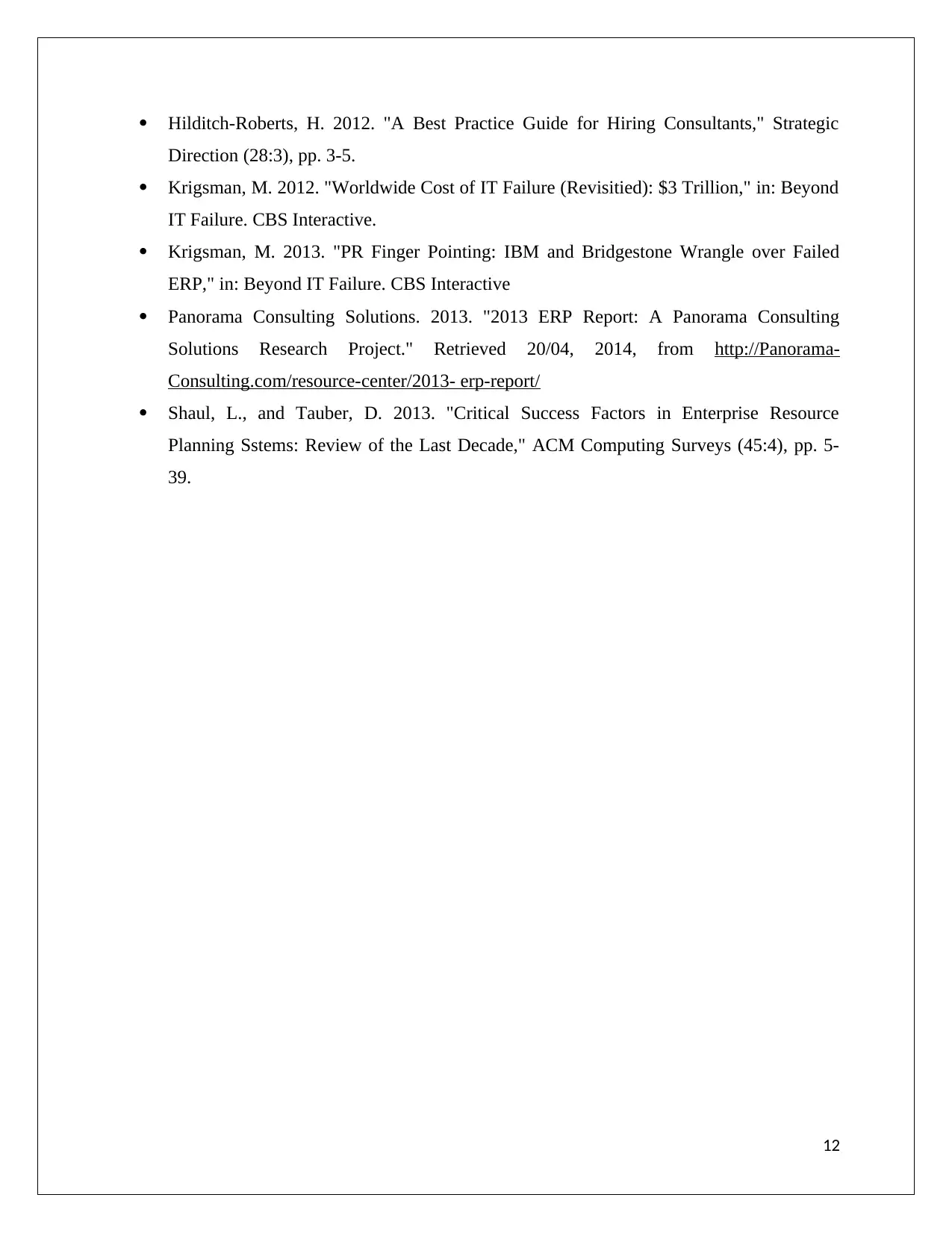
Hilditch-Roberts, H. 2012. "A Best Practice Guide for Hiring Consultants," Strategic
Direction (28:3), pp. 3-5.
Krigsman, M. 2012. "Worldwide Cost of IT Failure (Revisitied): $3 Trillion," in: Beyond
IT Failure. CBS Interactive.
Krigsman, M. 2013. "PR Finger Pointing: IBM and Bridgestone Wrangle over Failed
ERP," in: Beyond IT Failure. CBS Interactive
Panorama Consulting Solutions. 2013. "2013 ERP Report: A Panorama Consulting
Solutions Research Project." Retrieved 20/04, 2014, from http://Panorama-
Consulting.com/resource-center/2013- erp-report/
Shaul, L., and Tauber, D. 2013. "Critical Success Factors in Enterprise Resource
Planning Sstems: Review of the Last Decade," ACM Computing Surveys (45:4), pp. 5-
39.
12
Direction (28:3), pp. 3-5.
Krigsman, M. 2012. "Worldwide Cost of IT Failure (Revisitied): $3 Trillion," in: Beyond
IT Failure. CBS Interactive.
Krigsman, M. 2013. "PR Finger Pointing: IBM and Bridgestone Wrangle over Failed
ERP," in: Beyond IT Failure. CBS Interactive
Panorama Consulting Solutions. 2013. "2013 ERP Report: A Panorama Consulting
Solutions Research Project." Retrieved 20/04, 2014, from http://Panorama-
Consulting.com/resource-center/2013- erp-report/
Shaul, L., and Tauber, D. 2013. "Critical Success Factors in Enterprise Resource
Planning Sstems: Review of the Last Decade," ACM Computing Surveys (45:4), pp. 5-
39.
12
⊘ This is a preview!⊘
Do you want full access?
Subscribe today to unlock all pages.

Trusted by 1+ million students worldwide
1 out of 12
Related Documents
Your All-in-One AI-Powered Toolkit for Academic Success.
+13062052269
info@desklib.com
Available 24*7 on WhatsApp / Email
![[object Object]](/_next/static/media/star-bottom.7253800d.svg)
Unlock your academic potential
Copyright © 2020–2025 A2Z Services. All Rights Reserved. Developed and managed by ZUCOL.




